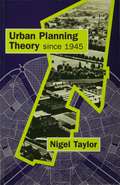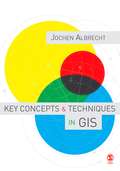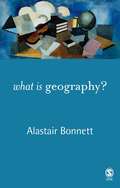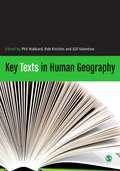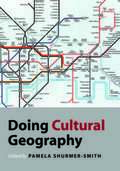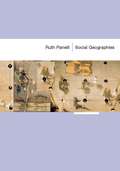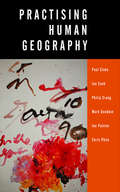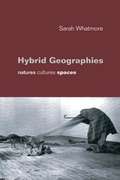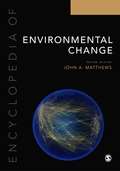- Table View
- List View
Urban Planning Theory since 1945
by Dr Nigel TaylorFollowing the Second World War, modern systems of urban and regional planning were established in Britain and most other developed countries. In this book, Nigel Taylor describes the changes in planning thought which have taken place since then. He outlines the main theories of planning, from the traditional view of urban planning as an exercise in physical design, to the systems and rational process views of planning of the 1960s; from Marxist accounts of the role of planning in capitalist society in the 1970s, to theories about planning implementation, and more recent views of planning as a form of `communicative action'.
Key Concepts and Techniques in GIS
by Jochen AlbrechtKey Concepts and Techniques in GIS is a concise overview of the fundamental ideas that inform geographic information science. It provides detailed descriptions of the concepts and techniques that anyone using GIS software must fully understand to analyse spatial data. Short and clearly focussed chapters provide explanations of: spatial relationships and spatial data the creation of digital data, the use and access of existing data, the combination of data the use of modelling techniques and the essential functions of map algebra spatial statistics and spatial analysis geocomputation - including discussion of neural networks, cellular automata, and agent-based modelling Illustrated throughout with explanatory figures, the text also includes a glossary, cross referenced to discussion in the text. Written very much from a user's perspective, Key Concepts and Techniques in GIS is highly readable refresher course for intermediate level students and practitioners of GIS in the social and the natural sciences.
What is Geography?
by Alastair Bonnett"I cannot imagine a better guide to the transition between school and undergraduate geography than this short, informative and confidently-argued book. Written without fuss but based on solid learning and clear thinking, it tackles head-on a question many professional academic geographers would rather avoid." - Alisdair Rogers, University of Oxford "A beautiful little book that helps to introduce the core concepts of geography and provides an ideal framework for relating other fields of knowledge and academia." - Stefan Zimmermann, University of Osnabruck What is Geography? Geography is a fundamental fascination with, and a crucial method for, understanding the way the world works. This text offers readers a short and highly accessible account of the ideas and concepts constituting geography. Drawing out the key themes that define the subject, What is Geography? demonstrates how and why these themes - like environment and geopolitics- are of fundamental importance. Including discussion of both the human and the natural realms, the text looks at key themes like environment, space, and place - as well as geography's methods and the history of the discipline. Introductory but not simplified, What is Geography? will provide students with the ability to understand the history and context of the subject without any prior knowledge. Designed as a key transitional text for students entering undergraduate courses, this book will be of interest to all readers interested in and intrigued by the "geographical imagination".
Key Texts in Human Geography (PDF)
by Rob Kitchin Phil Hubbard Gill Valentine"A book that will delight students… Key Texts in Human Geography is a primer of 26 interpretive essays designed to open up the subject's landmark monographs of the past 50 years to critical interpretation... The essays are uniformly excellent and the enthusiasm of the authors for the project shines through… It will find itself at the top of a thousand module handouts." - THE Textbook Guide "Will surely become a ‘key text’ itself. Read any chapter and you will want to compare it with another. Before you realize, an afternoon is gone and then you are tracking down the originals." - Professor James Sidaway, University of Plymouth 'An essential synopsis of essential readings that every human geographer must read. It is highly recommended for those just embarking on their careers as well as those who need a reminder of how and why geography moved from the margins of social thought to its very core." - Barney Warf, Florida State University Undergraduate geography students are often directed to 'key' texts in the literature but find them difficult to read because of their language and argument. As a result, they fail to get to grips with the subject matter and gravitate towards course textbooks instead. Key Texts in Human Geography serves as a primer and companion to the key texts in human geography published over the past 40 years. It is not a reader, but a volume of 26 interpretive essays highlighting: the significance of the text how the book should be read reactions and controversies surrounding the book the book's long-term legacy. It is an essential reference guide for all students of human geography and provides an invaluable interpretive tool in answering questions about human geography and what constitutes geographical knowledge.
Doing Cultural Geography
by Dr Pamela Shurmer-SmithDoing Cultural Geography is an introduction to cultural geography that integrates theoretical discussion with applied examples. The emphasis throughout is on doing. Recognising that many undergraduates have difficulty with both theory and methods courses, the text demystifies the 'theory' informing cultural geography and encourages students to engage directly with theory in practice. It emphasises what can be done with humanist, Marxist, post-structuralist, feminist, and post-colonial theory, demonstrating that this is the best way to prompt students to engage with the otherwise daunting theoretical literature. Twenty short chapters are grouped into five sections on Theory, Topic Selection, Methodology, Interpretation and Presentation. The main text is intercut with questions, suggestions for activities and short sample extracts from scholarly texts, chosen to exemplify the subject of the chapter and to stimulate further reading. Chapters conclude with glossaries and suggestions for further reading. Doing Cultural Geography will facilitate project work from small, classroom-based activities to the planning stages of undergraduate research projects. It will be essential reading for students in modules in cultural geography and foundation courses in human geography and theory and methods.
Social Geographies: From Difference to Action (PDF)
by Dr Ruth PanelliHow do we describe ourselves? Where have we, do we, will we, live our lives? Why are the differences between people a source of tension? How can social change occur? Social geography can assist in addressing these questions. It provides ways of understanding and living in our contemporary world. Providing students with the resources to understand both the theoretical and empirical approaches social geographers take when investigating social difference, this text outlines key theoretical approaches and traces the core geographies of difference: class, gender, race/ethnicity, and sexuality. It concludes by showing how geographers work across these ideas of difference to understand questions of identity, power and action. Using illustrative examples from around the world, Social Geographies includes: - Individual chapters on the main theoretical approaches to difference - Individual chapters on the key concepts of identity, power and action - Reviews of the core literature, with suggestions for further reading - Biographies of key contemporary social geographers - Glossary of key terms For students beginning human geography courses, or in social geography modules, this book is the essential primer.
Practising Human Geography (PDF)
by Professor Paul J Cloke Professor Mark A Goodwin Philip Crang Joe Painter Ian Cook Christopher Philo Philo'Filling an enormous gap in the geographic literature, here is a terrific book that shows us how to think about and practice human geographic research' - Professor Jennifer Wolch, University of Southern California `Practising Human Geography lucidly, comprehensively, and sometimes passionately shows why methodology matters, and why it is often so hard. To choose a method is to choose the kind of geographical values one wants to uphold. You need to get it right.These authors do' - Trevor Barnes, University of British Columbia `Practising Human Geography is a godsend for students. Written in an accessible and engaging style, the book demystifies the study of geographical methodology, offering a wealth of practical advice from the authors' own research experience. This is not a manual of approved geographical techniques. It is a reflexive, critical and highly personal account, combining historical depth with up-to-the-minute examples of research in practice. Practising Human Geography is a comprehensive and theoretically informed introduction to the practices of fieldwork, data collection, interpretation and writing, enabling students to make sense of their own data and to develop a critical perspective on the existing literature. The book makes complicated ideas approachable through the effective use of case studies and a firm grasp of contemporary debates' - Peter Jackson, Professor of Human Geography, University of Sheffield Practising Human Geography is a critical introduction to key issues in the practice of human geography, informed by the question 'how do geographers do research?' In examining those methods and practices that are essential to doing geography, the text presents a theoretically-informed discussion of the construction and interpretation of geographical data - including: the use of core research methodologies; using official and non-official sources; and the interpretative role of the researcher. Framed by an overview of how ideas of practising human geography have changed, the twelve chapters offer a comprehensive and integrated overview of research methodologies. The text is illustrated throughout with text boxes, case studies, and definitions of key terms. Practising Human Geography will introduce geographers - from undergraduate to faculty - to the core issues that inform research design and practice.
Hybrid Geographies: Natures Cultures Spaces (PDF)
by Sarah Whatmore`Hybrid Geographies is one of the most original and important contributions to our field in the last 30 years. At once immensley provocative and productive, it is written with uncommon clarity and grace, and promises to breathe new life not only into geographical inquiry but into critical practice across the spectrum of the humanities and social sciences - and beyond. An extraordinary achievement' - Professor Derek Gregory, Department of Geography, University of British Columbia Hybrid Geographies critically examines the `opposition' between nature and culture, the material and the social, as represented in scientific, environmental and popular discourses. Demonstrating that the world is not an exclusively human achievement, Hybrid Geographies reconsiders the relation between human and non-human, the social and the material, showing how they are intimately and variously linked. General arguments - informed by work in critical geography, feminist theory, environmental ethics, and science studies - are illustrated throughout with detailed case-study material. This exemplifies the two core themes of the book: a consideration of hybridity (the human/non-human relation) and of the `fault-lines' in the spatial organization of society and nature. Hybrid Geographies is essential reading for students in the social sciences with an interest in nature, space and social theory.
Geographies of Consumption (PDF)
by Juliana MansveltThis critical introduction to consumption and its geographies provides an engaged summary of the consumption literature and demonstrates that consumption is intimately related to the production of space in everyday life. In Geographies of Consumption Juliana Mansvelt provides readers with a detailed explanation of political-economic and social-cultural perspectives on consumption at different scales. She opens with overview chapters on the history and conceptualisation of consumption and moves on to thematic chapters on consumption spaces; the body and identity; commodity chains; globalization commercial cultures. The text is illustrated throughout with comparative case study-material and features boxes and annotated notes for further reading. A review of consumption from a spatial perspective, this critical analysis of the key debates is the first synoptic overview in the geographic literature. Geographies of Consumption will be widely used in modules in economic and social geography, and should be the core text for those with a focus on consumption
Health and Inequality: Geographical Perspectives (PDF)
by Dr Sarah Curtis`At last! A tour de force on cities and health by someone who knows that geography matters. This is a groundbreaking text, preoccupied as much with health and well-being as with death, disease and despair. It is concerned with who wins and who loses from the social and spatial patterning of risk… Combining breadth of coverage with depth of analysis, Health and Inequality provides an intricate map of harmful spaces and healing places, together with some guidelines on how to get from one to the other' - Professor Susan Smith, Ogilvie Professor of Geography, University of Edinburgh 'Too often as health professionals we remain embedded in nursing and medical literature neglecting the opportunities offered through engaging with other bodies of knowledge. Such an opportunity presents itself in this book which draws on work undertaken by geographers that can help us in our thinking about health inequalities. The strength of this work lies in its aim to ensure that place and space are recognised as significant factors in health inequalities' - Community Practitioner Health and Inequality presents a comprehensive analysis of how geographical perspectives can be used to understand the problems of health inequalities. The text has three principal themes: to discuss the geography of health inequality and to examine strategies for reducing disadvantage; to review and develop the theoretical basis for a geographical analysis of these problems - the discussion will illustrate how theoretical developments can help in the design and evaluation of intervention; and to explain how different methodologies in the geography of health, both quantitative and qualitative, can be applied in research - demonstrating the complementarity between them. By relating theoretical arguments to specific landscapes, Health and Inequality will be a key resource for understanding the articulation between theory and empirical methods for understanding health variation in urban areas.
The SAGE Handbook of Environmental Change: Human Impacts and Responses
by John A MatthewsThe SAGE Handbook of Environmental Change is an extensive survey of the interdisciplinary science of environmental change, including recent debates on climate change and the full range of other natural and anthropogenic changes affecting the Earth-ocean-atmosphere system in the past, present and future. It examines the historic importance, present status and future prospects of the field over two volumes. With more than 40 chapters, the books situate the defining characteristics and key paradigms within a state-of-the-art review of the field, including its changing nature and diversity of approaches, evidence base, key theoretical arguments, resonances with other disciplines and relationships between theory, research and practice. Opening with a detailed, contextualizing essay by the editors, the work is arranged into six parts: Part One: Approaches to Understanding Environmental Change Part Two: Evidence of Environmental Change and the Geo-ecological Response Part Three: Causes, Mechanisms and Dynamics of Environmental Change Part Four: Key Issues of Human-induced Environmental Changes and Their Impacts Part Five: Patterns, Processes and Impacts of Environmental Change at the Regional Scale Part Six: Responses of People to Environmental Change and Implications for Society Global in its coverage, scientific and theoretical in its approach, the books bring together an international set of respected editors and contributors to provide an exciting, timely addition to the literature on climate change. With the subjects' interdisciplinary framework, this book will appeal to academics, researchers, postgraduates and practitioners in a variety of disciplines including, geography, geology, ecology, environmental science, archaeology, anthropology, politics and sociology.
The SAGE Handbook of Biogeography
by Mark Blumler Professor Andrew C Millington Udo Schickhoff"A superb resource for understanding the diversity of the modern discipline of biogeography, and its history and future, especially within geography departments. I expect to refer to it often." - Professor Sally Horn, University of Tennessee "As you browse through this fine book you will be struck by the diverse topics that biogeographers investigate and the many research methods they use.... Biogeography is interdisciplinary, and a commonly-voiced concern is that one biogeographer may not readily understand another's research findings. A handbook like this is important for synthesising, situating, explaining and evaluating a large literature, and pointing the reader to informative publications." - Geographical Research "A valuable contribution in both a research and teaching context. If you are biologically trained, it provides an extensive look into the geographical tradition of biogeography, covering some topics that may be less familiar to those with an evolution/ecology background. Alternatively, if you are a geography student, researcher, or lecturer, it will provide a useful reference and will be invaluable to the non-biogeographer who suddenly has the teaching of an introductory biogeography course thrust upon them." - Adam C. Algar, Frontiers of Biogeography The SAGE Handbook of Biogeography is a manual for scoping the past, present and future of biogeography that enable readers to consider, where relevant, how similar biogeographical issues are tackled by researchers in different 'schools'. In line with the concept of all SAGE Handbooks, this is a retrospective and prospective overview of biogeography that will: Consider the main areas of biogeography researched by geographers Detail a global perspective by incorporating the work of different schools of biogeographers Ecplore the divergent evolution of biogeography as a discipline and consider how this diversity can be harnessed Examine the interdisciplinary debates that biogeographers are contributing to within geography and the biological sciences. Aimed at an international audience of research students, academics, researchers and practitioners in biogeography, the text will attract interest from environmental scientists, ecologists, biologists and geographers alike.
The SAGE Handbook of Geomorphology
by Andrew S Goudie Kenneth J. GregoryGeomorphology is the study of the Earth's diverse physical land-surface features and the dynamic processes that shape these features. Examining natural and anthropogenic processes, The SAGE Handbook of Geomorphology is a comprehensive exposition of the fundamentals of geomorphology that examines form, process, and applications of the discipline. Organized into five substantive sections, the Handbook is an overview of: • Foundations and Relevance: including the nature and scope of geomorphology; the origins and development of geomorphology; the role and character of theory in geomorphology; geomorphology and environmental management; and geomorphology and society • Techniques and Approaches: including observations and experiments; geomorphological mapping; the significance of models; process and form; dating surfaces and sediment; remote sensing in geomorphology; GIS in geomorphology; biogeomorphology; human activity • Process and Environment: including the evolution of regolith; weathering; fluids, flows and fluxes; sediment transport and deposition; hill slopes; riverine environments; glacial geomorphology; periglacial environments; coastal environments; aeolian environments; tropical environments; karst and karst processes • Environmental Change: including landscape evolution and tectonics; interpreting quaternary environments; environmental change; disturbance and responses to geomorphic systems • Conclusion: including challenges and perspectives; and a concluding review The Handbook has contributions from 48 international authors and was initially organized by the International Association of Geomorphologists. This will be a much-used and much-cited reference for researchers in Geomorphology, Physical Geography and the Environmental Sciences.
Encyclopedia of Environmental Change: Three Volume Set
by John A MatthewsAccessibly written by a team of international authors, the Encyclopedia of Environmental Change provides a gateway to the complex facts, concepts, techniques, methodology and philosophy of environmental change. This three-volume set illustrates and examines topics within this dynamic and rapidly changing interdisciplinary field. The encyclopedia includes all of the following aspects of environmental change: Diverse evidence of environmental change, including climate change and changes on land and in the oceans Underlying natural and anthropogenic causes and mechanisms Wide-ranging local, regional and global impacts from the polar regions to the tropics Responses of geo-ecosystems and human-environmental systems in the face of past, present and future environmental change Approaches, methodologies and techniques used for reconstructing, dating, monitoring, modelling, projecting and predicting change Social, economic and political dimensions of environmental issues, environmental conservation and management and environmental policy Over 4,000 entries explore the following key themes and more: Conservation Demographic change Environmental management Environmental policy Environmental security Food security Glaciation Green Revolution Human impact on environment Industrialization Landuse change Military impacts on environment Mining and mining impacts Nuclear energy Pollution Renewable resources Solar energy Sustainability Tourism Trade Water resources Water security Wildlife conservation The comprehensive coverage of terminology includes layers of entries ranging from one-line definitions to short essays, making this an invaluable companion for any student of physical geography, environmental geography or environmental sciences.
The Basics of Geomorphology: Key Concepts
by John Lewin Kenneth J. Gregory"I can think of no better guides than Professors Ken Gregory and John Lewin to lead the reader through the conceptual basis of this exciting science." - Victor R. Baker, University of Arizona "A very readable and informative introduction to the discipline for senior undergraduates, postgraduates and researchers." - Angela Gurnell, Queen Mary University of London "Time will tell, but this book may well mark a turning point in the way students and scientists alike perceive Earth surface processes and landforms." - Jonathan Phillips, University of Kentucky This student focused book provides a detailed description and analysis of the key concepts, ideas, and hypotheses that inform geomorphology. Kenneth Gregory and John Lewin explain the basics of landform science in 20 concepts, each the subject of a substantive, cross-referenced entry. They use the idea of the 'geomorphic system' to organise entries in four sections, with extensive web resources provided for each: System Contexts: The Systems Approach / Uniformitarianism / Landform / Form, Process and Materials / Equilibrium / Complexity and Non Linear Dynamical Systems System Functioning: Cycles and cascades / Force-Resistance / Geomorphic work / Process Form Models System Adjustments: Timescales / Forcings / Change Trajectories / Inheritance and Sensitivity / Anthropocene Drivers for the Future: Geomorphic Hazards / Geomorphic Engineering / Design and Prediction Aligned with the teaching literature, this innovative text provides a fully-functioning learning environment for study, revision, and even self-directed research for both undergraduate and postgraduate students of geomorphology.
Key Concepts in Historical Geography
by David Nally John Morrissey Ulf Strohmayer Yvonne Whelan"This ambitious volume reviews the best recent work in historical geography... It demonstrates how a dual sense of history and geography is necessary to understand such key areas of contemporary debate as the inter-relationship between class, race and gender; the character of nations and nationalism; the nature and challenges of urban life; the legacies of colonialism; and the meaning and values attributed to places, landscapes and environments." - Mike Heffernan, University of Nottingham Key Concepts in Historical Geography forms part of an innovative set of companion texts for the Human Geography sub-disciplines. Organized around 24 short essays, it provides a cutting edge introduction to the central concepts that define contemporary research in Historical Geography. Involving detailed and expansive discussions, the book includes: An introductory chapter providing a succinct overview of the recent developments in the field 24 key concepts entries with comprehensive explanations, definitions and evolutions of the subject Pedagogic features that enhance understanding including a glossary, figures, diagrams and further reading Key Concepts in Historical Geography is an ideal companion text for upper-level undergraduate and postgraduate students and covers the expected staples from the discipline - from people, space and place to colonialism and geopolitics - in an accessible style. Written by an internationally recognized set of authors, it is is an essential addition to any human geography student's library.
Population and Society
by Alan Marshall Dr Clare Holdsworth Dr Paul D Norman Nissa Finney"An excellent introduction to the study of population and its significance for many of the key social, political, cultural and environmental issues facing the world today. It covers population growth, ageing, migration and mobility, parenting, health inequalities, and much more... The authors do not shy away from areas of continuing debate, providing both sides of an argument and encouraging readers to follow up the original sources" - Tony Champion, Emeritus Professor of Population Geography, Centre for Urban, Regional & Development Studies, Newcastle University and Vice President, British Society for Population Studies, 2011-2013 Population and Society is an undergraduate introduction to population that explains the latest trends in population studies. The text provides a detailed and completely accessible overview that: situates demographic events - fertility, mortality and migration - within the context of broader social impacts and theorisations like social inequalities, individualisation and life course analysis uses global illustrative examples to demonstrate the importance of data and data interpretation in population studies is illustrated throughout with pedagogic features, like chapter opening summaries, suggestions for further readings and case study examples. This text will be widely used as the standard and most up-to-date text on population and society for courses across the social sciences.
Rural Geography: Processes, Responses and Experiences in Rural Restructuring
by Dr Michael Woods"Michael Woods has taken on the formidable task of giving an overview of rural places and society in advanced economies as a single author and has presented a book that rightly deserves to be called state-of-the-art." - Geographische Rundschau "With Rural Geography Michael Woods remedies the often underestimated dynamism of rural places and rural society by providing the much-needed synthesis of the European and North American literature on rural restructuring and globalization processes." - Patrick H Mooney, University of Kentucky Rural Geography is an introduction to contemporary rural societies and economies in the developed world. It examines the social and economic processes at work in the contemporary countryside - including the more traditional: like agriculture; land use; and population; as well as wider themes like: rural health, crime, exclusion, commodification; and alternative lifestyles. With a contextualising section defining the rural, the text is organised systematically in three principal sections: Processes of Rural Restructuring Responses to Rural Restructuring Experiences of Rural Restructuring Using the most recent empirical material , statistical data and research, the text is global in perspective using comparative examples throughout. Rural Geography is a systematic introduction to the processes, responses, and experiences of rural restructuring.
Key Concepts in Economic Geography
by James T Murphy Susan Hanson Yuko Aoyama"A comprehensive and highly readable review of the conceptual underpinnings of economic geography. Students and professional scholars alike will find it extremely useful both as a reference manual and as an authoritative guide to the numerous theoretical debates that characterize the field." - Allen J. Scott, University of California "Guides readers skilfully through the rapidly changing field of economic geography... The key concepts used to structure this narrative range from key actors and processes within global economic change to a discussion of newer areas of research including work on financialisation and consumption. The result is a highly readable synthesis of contemporary debates within economic geography that is also sensitive to the history of the sub-discipline." - Sarah Hall, University of Nottingham "The nice thing about this text is that it is concise but with depth in its coverage. A must have for any library, and a useful desk reference for any serious student of economic geography or political economy." - Adam Dixon, Bristol University Organized around 20 short essays, Key Concepts in Economic Geography provides a cutting edge introduction to the central concepts that define contemporary research in economic geography. Involving detailed and expansive discussions, the book includes: An introductory chapter providing a succinct overview of the recent developments in the field. Over 20 key concept entries with comprehensive explanations, definitions and evolutions of the subject. Extensive pedagogic features that enhance understanding including figures, diagrams and further reading. An ideal companion text for upper-level undergraduate and postgraduate students in economic geography, the book presents the key concepts in the discipline, demonstrating their historical roots and contemporary applications to fully understand the processes of economic change, regional growth and decline, globalization, and the changing locations of firms and industries. Written by an internationally recognized set of authors, the book is an essential addition to any geography student's library.
Qualitative GIS: A Mixed Methods Approach (PDF)
by Sarah Elwood Professor Meghan CopeGeographic Information Systems are an essential tool for analyzing and representing quantitative spatial data. Qualitative GIS explains the recent integration of qualitative research with Geographical Information Systems With a detailed contextualising introduction, the text is organised in three sections: Representation: examines how researchers are using GIS to create new types of representations; working with spatial data, maps, and othervisualizations to incorporate multiple meanings and to provide texture and context. Analysis: discusses the new techniques of analysis that are emerging at the margins between qualitative research and GIS, this in the wider context of a critical review of mixed-methods in geographical research Theory: questions how knowledge is produced, showing how ideas of 'science' and 'truth' inform research, and demonstrates how qualitative GIS can be used to interrogate discussions of power, community, and social action Making reference to representation, analysis, and theory throughout, the text shows how to frame questions, collect data, analyze results, and represent findings in a truly integrated way. An important addition to the mixed methods literature, Qualitative GIS will be the standard reference for upper-level students and researchers using qualitative methods and Geographic Information Systems.
The Economic Geography of the UK
by Dr Neil Coe Andrew JonesWith the UK still facing the repercussions of the 2007 economic downturn, Coe and Jones' text is a timely, engaging discussion of the key issues facing the UK economy from a purely geographical perspective, written by some of the leading academics in the field. With pedagogical features to facilitate learning, including further reading and chapter aims, the text explores the complex connections that constitute the UK economy including the city and finance, the uneven development of the UK, the UK economy's links to the European Union and its wider ties to the global economy. Written for geography students studying modules on economic geography and the human geography of the UK, the text is a vibrantly written, easy-to-understand analysis of the current and future challenges that face the contemporary UK economy. Includes a preface by Doreen Massey.
Qualitative GIS: A Mixed Methods Approach
by Professor Meghan Cope Sarah ElwoodGeographic Information Systems are an essential tool for analyzing and representing quantitative spatial data. Qualitative GIS explains the recent integration of qualitative research with Geographical Information Systems With a detailed contextualising introduction, the text is organised in three sections: Representation: examines how researchers are using GIS to create new types of representations; working with spatial data, maps, and othervisualizations to incorporate multiple meanings and to provide texture and context. Analysis: discusses the new techniques of analysis that are emerging at the margins between qualitative research and GIS, this in the wider context of a critical review of mixed-methods in geographical research Theory: questions how knowledge is produced, showing how ideas of 'science' and 'truth' inform research, and demonstrates how qualitative GIS can be used to interrogate discussions of power, community, and social action Making reference to representation, analysis, and theory throughout, the text shows how to frame questions, collect data, analyze results, and represent findings in a truly integrated way. An important addition to the mixed methods literature, Qualitative GIS will be the standard reference for upper-level students and researchers using qualitative methods and Geographic Information Systems.
Key Texts in Human Geography
by Gill Valentine Phil Hubbard Rob Kitchin"A book that will delight students… Key Texts in Human Geography is a primer of 26 interpretive essays designed to open up the subject's landmark monographs of the past 50 years to critical interpretation... The essays are uniformly excellent and the enthusiasm of the authors for the project shines through… It will find itself at the top of a thousand module handouts." - THE Textbook Guide "Will surely become a ‘key text’ itself. Read any chapter and you will want to compare it with another. Before you realize, an afternoon is gone and then you are tracking down the originals." - Professor James Sidaway, University of Plymouth 'An essential synopsis of essential readings that every human geographer must read. It is highly recommended for those just embarking on their careers as well as those who need a reminder of how and why geography moved from the margins of social thought to its very core." - Barney Warf, Florida State University Undergraduate geography students are often directed to 'key' texts in the literature but find them difficult to read because of their language and argument. As a result, they fail to get to grips with the subject matter and gravitate towards course textbooks instead. Key Texts in Human Geography serves as a primer and companion to the key texts in human geography published over the past 40 years. It is not a reader, but a volume of 26 interpretive essays highlighting: the significance of the text how the book should be read reactions and controversies surrounding the book the book's long-term legacy. It is an essential reference guide for all students of human geography and provides an invaluable interpretive tool in answering questions about human geography and what constitutes geographical knowledge.
Key Concepts in Urban Geography
by Alan Latham Derek Mccormack Donald Mcneill Kim Mcnamara"This extraordinary collage of sophisticated essays on key terms in urban geography both provides a conventional basis to and recasts innovatively a burgeoning field in the discipline." - Roger Keil, co-Editor, International Journal of Urban and Regional Research "The city is an obvious but confounding object of geographical analysis; urban structure and life are shaped by an astounding array of social, economic, and political dynamics. This volume embraces these complexities of city form in a wide-ranging, readable, well-informed, and highly interdisciplinary analysis of key topics in urban studies. With its fresh approach, this book provides an accessible entry point for the newcomer to urban geography, yet also delivers creative insights for those with greater familiarity." - Professor Steven K. Herbert, University of Washington Organized around 20 short essays, Key Concepts in Urban Geography provides a cutting-edge introduction to the central concepts that define contemporary research in urban geography. Involving detailed and expansive discussions, the book includes: An introductory chapter providing a succinct overview of the recent developments in the field. Over 20 key concept entries with comprehensive explanations, definitions and evolutions of the subject. A glossary, figures, diagrams and suggested further reading. This is an ideal companion text for upper-level undergraduate and postgraduate students in urban geography and covers the expected staples of the subdiscipline from global cities and urban nature to transnational urbanism and virtuality.
Key Concepts in Political Geography
by Alison Mountz Carl T Dahlman Carolyn Gallaher Dr Peter Shirlow Mary Gilmartin"A comprehensive reader for my political geography course. Good summaries at the end, and articles include effective case study examples." - Rachel Paul, Western Washington University "A very useful and comprehensive introduction to key concepts in political geography. This book provides useful context not just for 'traditional' political geography modules, but also those examining broader issues of power, resistance and social movements." - Gavin Brown, University of Leicester "Vital for introducing basic concepts and terminology in a clear and concise fashion. The short chapters are accessible and well supplemented with pertinent examples." - Daniel Hammett, Sheffield University "I found the book to be very useful in a supplemental capacity, full of information that would be useful for an undergraduate or early graduate student." - Jason Dittmer, University College London This textbook forms part of an innovative set of companion texts for the human geography subdisciplines. Organized around 20 short essays, Key Concepts in Political Geography provides a cutting-edge introduction to the central concepts that define contemporary research in the field. Involving detailed yet expansive discussions, the book includes: An introductory chapter providing a succinct overview of the recent developments in the field Over 20 key concept entries covering the expected staples of the sub-discipline, such as nationalism, territoriality, scale and political-economy, as well as relatively new arrivals to the field including the other, anti-statism, gender, and post-conflict A glossary, figures, diagrams and further reading. It is essential reading for undergraduate and postgraduate students of political geography.
